Intel HD Graphics 4000 and Intel HD Graphics 2500 Review

Ivy Bridge processors didn’t really impress us that much, because they didn’t turn out that much more advanced than their predecessors. However, we haven’t yet had a chance to really dig into the performance and features of their graphics cores. Let’s make up for this omission and test their graphics. What if obtained results completely change our opinion about them?
A few years ago it didn’t really make sense to discuss the performance of the integrated graphics cores. The only reason why you would rely on a solution like that would be the case when no 3D graphics is in the picture, because compared with the discrete graphics accelerators, integrated graphics cores offered minimalistic functionality in 3D modes. However, things have changed dramatically by now. Starting with 2007, the trendsetter for all major changes in the computer market, Intel Corporation, considers increasing the performance and functionality of the integrated graphics to be one of the primary objectives. And their accomplishments in this aspect have been truly impressive: integrated graphics core shave not only becomes substantially faster, but have also turned into an inalienable part of contemporary processors. Moreover, the company is not going to stop just yet and is working on a very ambitious plan of making integrated graphics another 10 times faster by 2015.
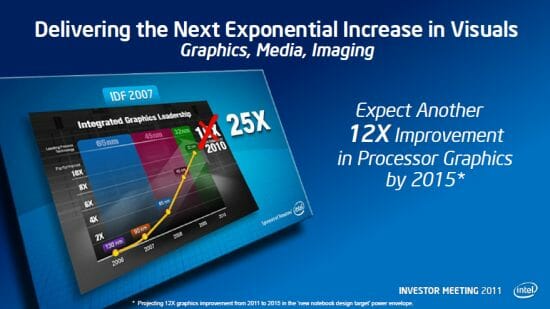
Developers’ sudden interest to improving their graphics cores was encouraged by the users’ desire to have at their disposal compact systems with high performance. It may seem that up until recently the term “mobile computer” stood for a system that could be easily moved from one place to another, size and weight being secondary. Today, even pretty small 4-lbs notebooks will hardly make many users happy. Tablets and ultra-compact systems, which Intel calls “ultrabooks”, have become the today’s trend. It is this hunt for miniature size and ultra-light weight has become the ultimate force pushing integrated graphics into contemporary processors and improving its performance. A single chip that represents a combination of a CPU and GPU and at the same time boasts low heat dissipation is the necessary basis for appealing contemporary mobile solutions. That is why we see a lot of activity in the hybrid processor segment, which offers numerous benefits not only to the users of mobile devices but also to the users of desktop systems.
Ivy Bridge processors are a second incarnation of Intel’s microarchitecture featuring hybrid design, which implies the coexistence of computational and graphics cores within a single semiconductor die. The previous microarchitecture version, Sandy Bridge, has undergone some radical changes, which has primarily touched upon the graphics core. Intel even had to make special clarifications regarding their “tick-tock” concept: Ivy Bridge was supposed to become the result of the previous design’s transition to new 22 nm process, but in reality they have also made a significant step forward in terms of graphics capabilities. Therefore, we decided to dedicate a whole separate article to the new graphics core in order to cover all the numerous improvements and investigate the remarkable performance boost.
You can get an excellent idea of how significant the changes are from comparing side by side Ivy Bridge and Sandy Bridge semiconductor dies.
Both of them are manufactured using different technologies and have different size. But there is one important observation: while the graphics core in Sandy Bridge occupied about 19% of the die, the graphics core in Ivy Bridge increased in size to 28%. And it means that the complexity of the graphics inside the processor has more than doubled: it increased from 189 to 392 mln transistors. Of course, such dramatic increase in the transistor count couldn’t have been wasted for nothing.
I have to stress that Intel’s approach towards marrying the computational and graphics cores and increasing the potential of the latter is somewhat different from AMD’s APU concept. Intel’s competition considers integrated graphics core inside the processor an extension of computational cores believing that flexible programmable shader processors will help increase the overall performance of the unit. As for Intel, they do not expect graphics to be widely used for computational tasks: the traditional computational potential of the Ivy Bridge processors is more than sufficient. In this case, the integrated graphics core has a pretty traditional primary function, and the developers’ intention to even further grow its potential is determined by the desire to reduce to minimum the situations when discrete graphics card becomes a necessary component, especially in mobile computer systems.
However, both approaches from Intel and AMD produce the same outcome. The market share of discrete graphics continues to drop giving way to new generation integrated graphics, which now supports DirectX 11 and works faster than an entire lineup of entry-level discrete graphics accelerators. Today we are going to talk about Intel HD Graphics 4000 and Intel HD Graphics 2500 cores integrated into Ivy Bridge processors. We will also try to figure out which discrete graphics cards have lost their market value with the launch of the new generation Intel graphics.
Closer Look at Intel HD Graphics 4000/2500 Architecture
It is not so easy to increase the performance if integrated graphics cores. And Intel’s ability to make it 10 times better over the past few years is the result of intensive engineering effort. The major obstacle here is the fact that integrated graphics accelerators can’t take advantage of dedicated high-speed video memory and have to share with the computational cores the regular system RAM with pretty low bandwidth for contemporary 3D applications. Therefore, the first step towards improving the integrated graphics performance is to optimize the work with the memory sub-system.
Intel accomplished this important step in the previous version of their microarchitecture – Sandy Bridge. The introduction of ring bus that connects all CPU components (computational cores, L3 cache, graphics, system agent with the memory controller) offered the graphics core a short and advanced way of communicating with the system memory – via the fast L3 cache. In other words, integrated graphics core became just as entitled to using the L3 cache and memory controller as the computational processor cores, which significantly reduced delays caused by the need to wait for the delivery of the graphics data. Ring bus turned out such a successful innovation of the previous design that they used it as is, without any modifications, in the new Ivy Bridge microarchitecture.
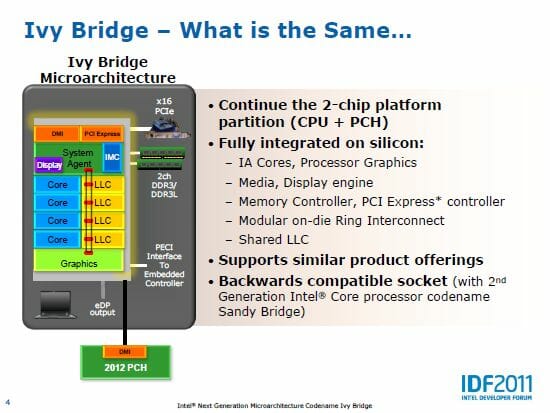
As for the internal structure of the Ivy Bridge graphics core, it may be considered a further evolution of the previous generation Intel HD Graphics. It goes as far back as Clarkdale and Arrandale processors introduced back in 2010, but each new incarnation represents not a copy of the previous design, but an improvement.
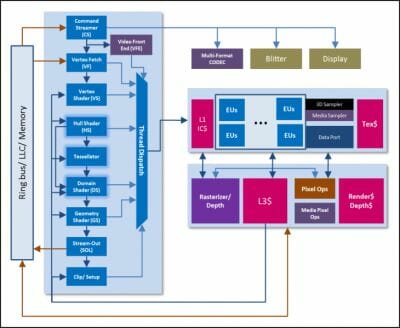
Upon transition from Sandy Bridge to Ivy Bridge microarchitecture, the graphics performance improves primarily due to the larger number of execution units, especially since the internal structure of HD Graphics allows adding them easily. While the top Sandy Bridge graphics core, HD Graphics 3000, had 12 execution units, the fastest modification integrated into the new Ivy Bridge, HD Graphics 4000, has 16 execution units. However, this is not just it: the units themselves were also improved. They received a second texturing sampler and learned to process up to 3 instructions per clock cycle.
The ability of the graphics core to process data faster forced the developers to speed up the data delivery. Therefore, the Ivy Bridge graphics core has its own cache-memory. Its size hasn’t been disclosed, but it is most likely a small but very fast internal buffer.
Although the improvements in the graphics core microarchitecture may seem minor at first glance, they produce noticeable improvement in 3D performance, of as much as 2x, according to Intel. By the way, the next generation of HD Graphics accelerators, which will be integrated into the upcoming Haswell processors should also boast a 2x performance increase. They should have up to 20 execution units and will utilize L4 cache in order to lower the latencies during work with the memory sub-system.
As for the Ivy Bridge graphics, increasing its performance wasn’t the only goal. Besides that, they also adjusted the formal specifications of the new graphics core to the today’s needs. It means that HD Graphics 4000 has finally received full support of Shader Model 5.0 and hardware tessellation. In other words, Intel’s graphics is now fully compatible on a hardware level with DirectX 11 and OpenGL 3.1 software interfaces. And of course, HD Graphics 4000 won’t have any problems in the upcoming Windows 8 operating system: the necessary drivers are already available on the official Intel web-site.
Intel also enabled the new graphics core to process necessary computational operations that is why the new generation HD Graphics supports DirectCompute 5.0 and OpenCL. Sandy Bridge processors also supported these software interfaces, but only in the driver, which would readdress the corresponding load to respective computational cores. Now Ivy Bridge allows using GPU for fully-fledged calculations in systems with Intel graphics.
In light of these new realities, Intel engineers decided to pay special attention to multi-monitor configurations, which are becoming increasingly popular these days. HD Graphics 4000 graphics core has become the first integrated solution from Intel, which is capable of working with three independent displays simultaneously. But it is important to keep in mind that they had to widen the FDI bus transferring images from the processor to the system chipset. So, three-monitor configurations can only be built with new mainboards based on the seventh series chipsets.
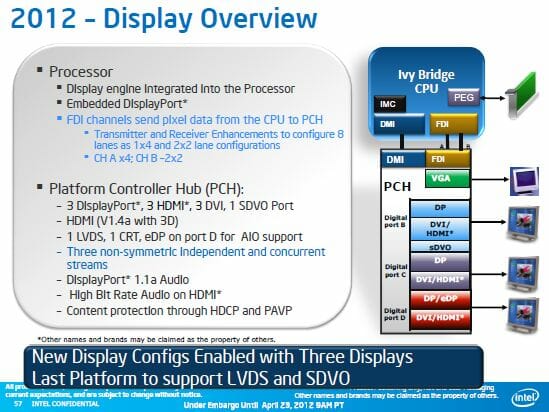
Moreover, there are a few limitations in resolutions and monitor connection types. Theoretically, a desktop system on an Ivy Bridge processor can offer three outs: the first one – a universal out (HDMI, DVI, VGA or DisplayPort) with maximum resolution of 1920×1200, the second one – a DisplayPort, HDMI or DVI with up to 1920×1200 resolution, and the third one – a DisplayPort supporting higher resolutions up to 2560×1600. In other words, a popular connection option when WQXGA monitors are connected to Intel HD Graphics 4000 via Dual-Link DVI is still unavailable. However, it supports HDMI protocol version 1.4a, and DisplayPort version 1.1a, which means 3D support in the former case and the ability of the interface to transfer audio stream – in the latter.
Innovations have also touched upon some other parts of the Ivy Bridge graphics core, including their multimedia capabilities. High-quality decoding of AVC/H.264, VC-1 and MPEG-2 formats was implemented successfully in the previous generation of HD Graphics, but in Ivy Bridge they improved AVC-decoding algorithms even more. New design of the context-adaptive decoding module improved the overall performance of the hardware decoder, which enabled simultaneous displaying of several data streams with up to 4096×4096 resolution.
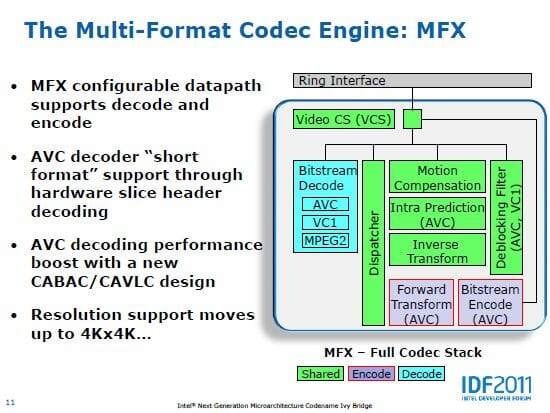
The Quick Sync technology accelerating hardware transcoding into AVC/H.264 format has also experienced a touch of progress. It was recognized as a significant breakthrough when it was first introduced in Sandy Bridge processors 1.5 years ago. It put Intel processors at the forefront of HD video transcoding, because now there was a special hardware unit within the graphics core responsible for it. Quick Sync technology in HD Graphics 4000 has been improved even more and received an enhanced media sampler. As a result, the enhanced Quick Sync engine almost doubles the H.264 transcoding speed of the previous version used in Sandy Bridge. Moreover, the image quality of the video produced by the codec has also improved, and it now supports HD video content with up to 4096×4096 resolution.
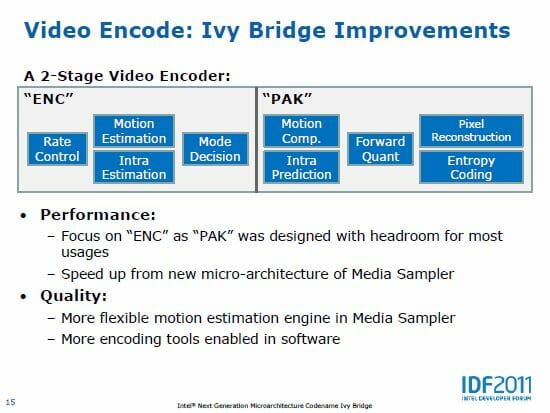
However, Quick Sync still has a few weak spots. Right now this technology is only utilized in commercial video transcoding applications. And there are no free utilities out there that would take advantage of this technology. Another issue is too close of a connection with the graphics core. If there is an external graphics accelerator in your system, which will normally disable the integrated graphics, you won’t be able to use Quick Sync at all. Although LucidLogix Company has a solution for you: their virtualization technology called Virtu.
Nevertheless, Quick Sync remains a unique technology in the today’s market. The special hardware codec implemented as part of this technology offers much better transcoding than the shader processors of contemporary graphics accelerators could offer. Only Nvidia managed so far to come up with an alternative hardware solution. Although their special NVEnc unit has just recently appeared in the graphics accelerators from the latest Kepler generation.
Summing up all the innovations in the new generation integrated graphics core from Intel, we would like to show you the following chart highlighting the advantages of the new HD Graphics 4000 compared with the predecessors:
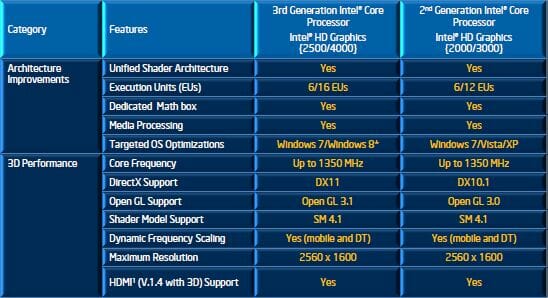
Intel HD Graphics 4000 vs. Intel HD Graphics 2500: What’s Different?
Just as before, Intel integrates two graphics core models into their Ivy Bridge. This time they are HD Graphics 4000 and HD Graphics 2500. The top high-performance model, which we mostly focused on in the previous chapter of our review, absorbed all the new microarchitectural improvements. As for the junior graphics core model, it is not expected to set any new performance standards for integrated solutions, but should merely provide contemporary processors with the minimum necessary graphics functionality.
HD Graphics 4000 and HD Graphics 2500 differ dramatically from one another. The faster graphics core modification has 16 execution units, while the slower one has only six. As a result, while HD Graphics 4000 is almost twice as fast as the previous generation HD Graphics 3000 in theoretical 3D performance, the advantage of the HD Graphics 2500 over HD Graphics 2000 is promised to be around 10-20%. The same is true for QuickSync: only the top graphics core modifications should deliver twice the performance compared with their predecessors.
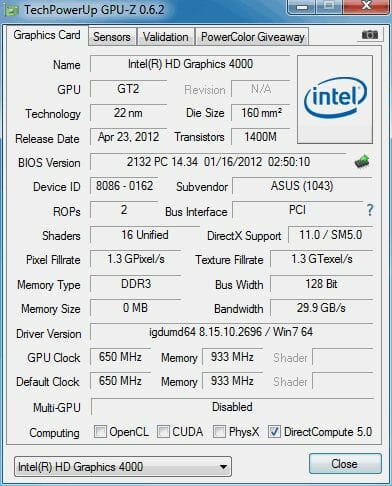
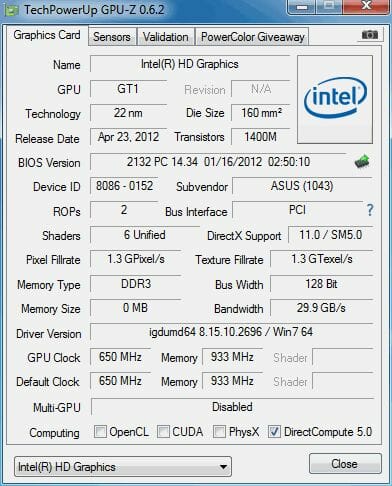
However, not all products in the Ivy Bridge family feature the fully-fledged HD Graphics 4000 graphics core. It can is more popular in mobile solutions, where integrated CPU graphics is in demand. The desktop processors with HD Graphics 4000 are either the CPU from the Core i7 series, or the overclocker Core i5 models (with the “K” index in their model name). The only exception from the latter is the Core i5-3475S CPU. In all other instances, desktop users will be either dealing with HD Graphics 2500 or using external graphics accelerators.
Luckily, it was only the performance gap between the senior and junior Intel graphics modifications that increased. The functionality of HD Graphics 2500 didn’t suffer in any way. Just like the HD Graphics 4000, the junior model supports DirectX 11 and triple-display configurations.
It is important to point out that, just as before, the graphics core in third-generation Core processors may work at different frequencies. For example, Intel cares more about integrated graphics performance in respect to mobile solutions, which is reflected by the operational frequencies. In most cases, the HD Graphics 4000 core in mobile Ivy Bridge processors works at a slightly higher frequency than in desktop CPUs. Moreover, the heat dissipation limitations of different processor models may also determine the differences in the integrated graphics core frequencies.
Besides, the graphics core frequency is a variable parameter. Ivy Bridge processors support Intel HD Graphics Dynamic Frequency, which adjusts the frequency of the integrated graphics core dynamically depending on the CPU utilization, power consumption and heat dissipation at a given moment.
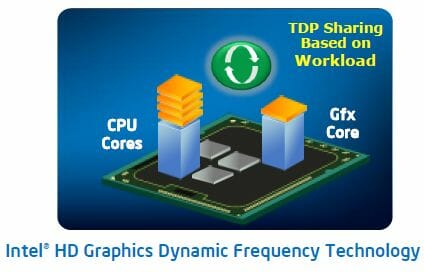
Therefore, there are two frequencies in the list of technical parameters for specific HD Graphics implementations: min and max. The minimum frequency is typical of the idle mode, while the maximum frequency is the goal frequency for the graphics core provided the power consumption and heat dissipation allow this speed boost.
The table below contains all major technical details about the Intel HD Graphics core modifications used in third-generation Core processors:
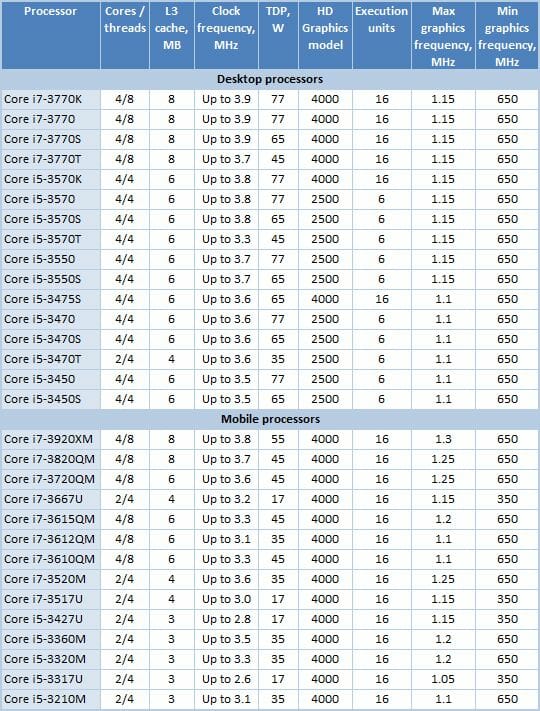
Testbed Configuration and Testing Methodology
During this test session we decided to compare the performance of the new Intel HD Graphics 4000 and Intel HD Graphics 2500 cores integrated into Ivy Bridge processors against the performance of the previous generation and competitive integrated GPU and discrete entry-level graphics cards. We are going to perform this comparison in desktop platforms, although obtained results are also applicable to mobile systems.
There are currently two processors with integrated graphics in the market that can be compared against Ivy Bridge: AMD Vision from A8/A6 series and Intel Sandy Bridge. They will be competing against a system based on third-generation Core i5 processors featuring Intel HD Graphics 2500 and Intel HD Graphics 4000 cores. Moreover, we also included low-cost discrete graphics cards from AMD 6xxx series – Radeon HD 6450 and Radeon HD 6570.
Unfortunately, while comparing the integrated graphics cores, we can’t ensure that the rest of the system components are identical throughout all platforms. Different cores belong to different processors with different operational frequencies and microarchitectures. Therefore, we had to come up with maximally close, though not identical configurations. For our LGA 1155 platform we took only Core i5 processors, which will compete against AMD Vision processors from Llano family. The discrete graphics cards were tested in an Ivy Bridge system.
As a result, we used the following hardware and software components:
- Processors:
- Intel Core i5-3570K (Ivy Bridge, 4 cores, 3.4-3.8 GHz, 6 MB L3, HD Graphics 4000);
- Intel Core i5-3550 (Ivy Bridge, 4 cores, 3.3-3.7 GHz, 6 MB L3, HD Graphics 2500);
- Intel Core i5-2500K (Sandy Bridge, 4 cores, 3.3-3.7 GHz, 6 MB L3, HD Graphics 3000);
- Intel Core i5-2400 (Sandy Bridge, 4 cores, 3.1-3.4 GHz, 6 MB L3, HD Graphics 2000);
- AMD A8-3870K (Llano, 4 cores, 3.0 GHz, 4 MB L2, Radeon HD 6550D);
- AMD A6-3650 (Llano, 4 cores, 2.6 GHz, 4 MB L2, Radeon HD 6530D).
- Mainboards:
- ASUS P8Z77-V Deluxe (LGA1155, Intel Z77 Express);
- Gigabyte GA-A75-UD4H (Socket FM1, AMD A75).
- Graphics cards:
- AMD Radeon HD 6570 1 GB GDDR5 128-bit;
- AMD Radeon HD 6450 512 MB GDDR5 64-bit.
- Memory: 2 x 4 GB, DDR3-1866 SDRAM, 9-11-9-27 (Kingston KHX1866C9D3K2/8GX).
- Disk sub-system: Crucial m4 256 GB (CT256M4SSD2).
- Power supply unit: Tagan TG880-U33II (880 W).
- Operating system: Microsoft Windows 7 SP1 Ultimate x64.
- Drivers:
- AMD Catalyst 12.4 Driver;
- AMD Chipset Driver 12.4;
- Intel Chipset Driver 9.3.0.1019;
- Intel Graphics Media Accelerator Driver 15.28.0.64.2729;
- Intel Rapid Storage Technology 10.8.0.1003.
Quite naturally, the major focus of this test session was on the gaming performance. Therefore, most of the benchmarks we used were games or special gaming benchmarks. In fact, the potential of contemporary integrated graphics accelerators has already improved so dramatically that we were actually able to run the tests not only in low resolution of 1366×768, but also in the de-facto standard resolution for desktop FullHD systems – 1980×1080. Though in the latter case we used only low image quality settings.
3D Performance
Before we precede to the actual performance results, we should say a few words about the compatibility of the HD Graphics 4000/2500 graphics accelerators with various games. Previously, it was quite common that some games wouldn’t work with Intel’s graphics at all or would work incorrectly. However, things have definitely changed for the better by now. Every new version of the graphics accelerator and driver expands the list of fully compatible gaming titles, and in case of the new HD Graphics 4000/2500 there are hardly any critical issues left. However, if you are still skeptical about the potential of the Intel’s integrated graphics cores, you can check the extensive list of popular games on Intel’s official web-site (list 1, list 2), which compatibility has been tested and which have demonstrated acceptable gaming performance.
3DMark Vantage
3DMark scores are a very popular way of estimating average gaming performance. Therefore, we decided to start with 3DMark. And we chose Vantage suite because it uses DirectX 10 that all the participating graphics accelerators support.
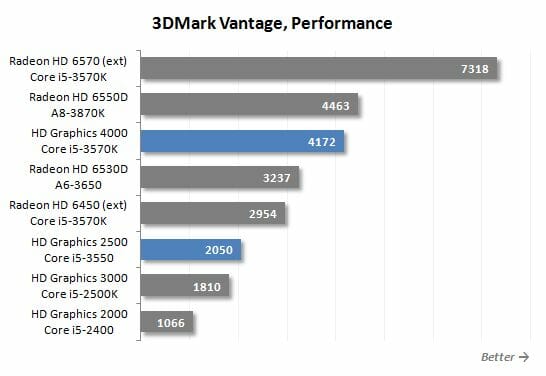
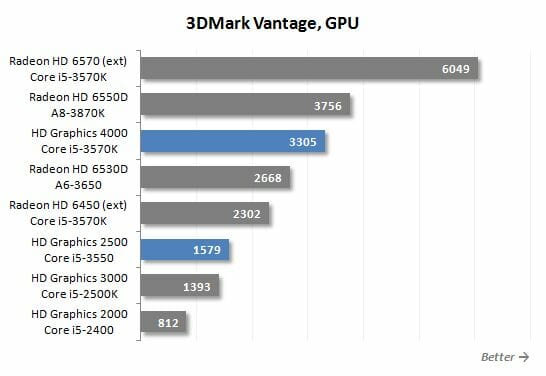
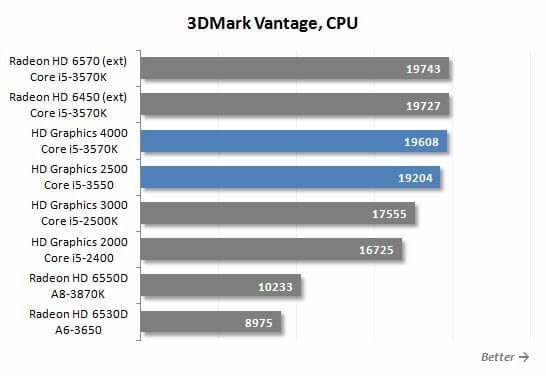
The first diagrams show very clearly how significantly the new HD Graphics cores have improved. HD Graphics 4000 is more than twice as fast as HD Graphics 3000. The junior 2500 model also does very well: it is almost twice as fast as HD Graphics 2000, even though both these accelerators have the same number of execution units.
3DMark 11
A newer 3DMark suite measures DirectX 11 performance. Therefore, all integrated graphics cores of the second generation Core processors do not take part in this test.
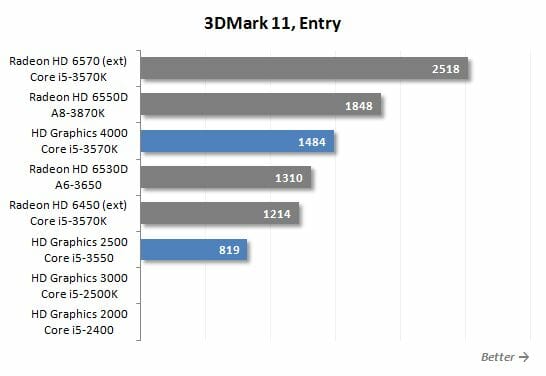
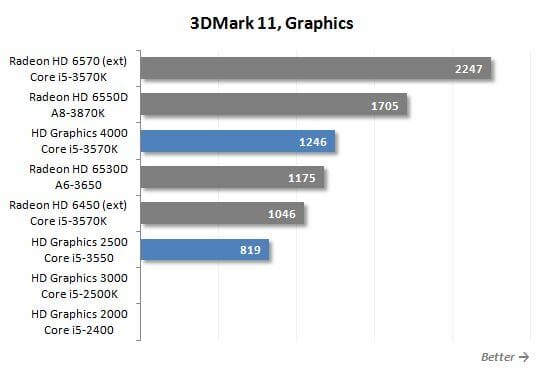
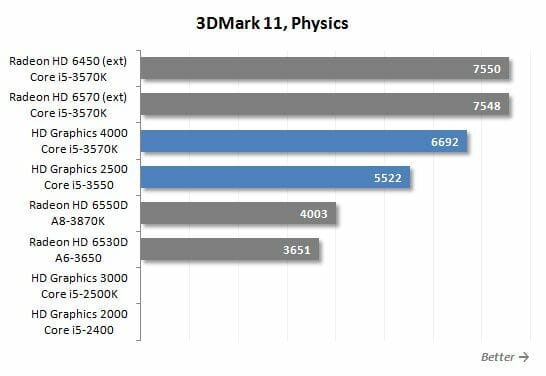
The graphics core in Ivy Bridge processors is the first graphics accelerator from Intel that managed to pass the 3DMark 11 tests using DirectX 11 without any image quality issues. HD Graphics 4000 is pretty fast in this suite. It outperforms the discrete Radeon HD 6450 graphics card and the Radeon HD 6530D graphics core integrated into AMD A6-3650 processor. It only yields to the senior integrated core modification in Llano processors and Radeon HD 6570 graphics card priced at about $60-$70. As for the junior modification of the new Intel’s graphics core, HD Graphics 2500, it takes the last place in this test. No doubt, the ruthlessly limited number of execution units has inevitable negative effect on gaming performance.
Batman Arkham City
We will start our actual games tests with a relatively new title – Batman Arkham City based on Unreal Engine 3.
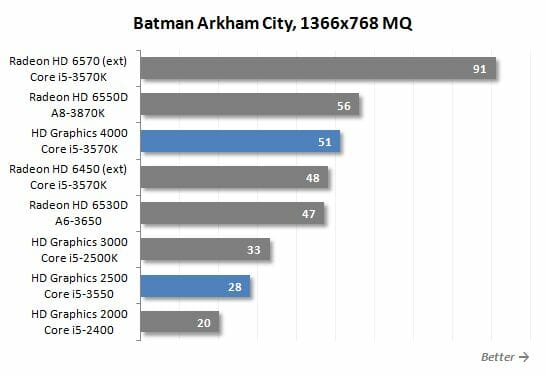
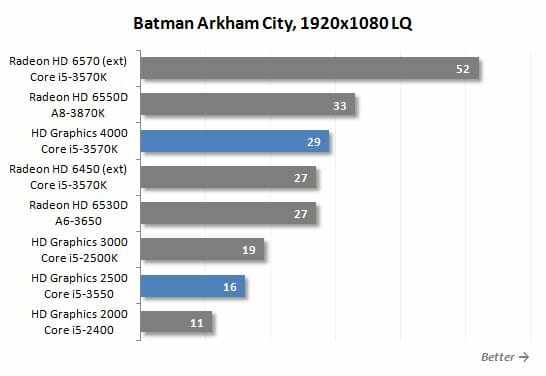
As you can see from the obtained results, the performance of integrated Intel graphics has increased so significantly that we are now able to play pretty current games in FullHD resolution. And even though we can’t get good image quality or sufficient fps rate for absolutely comfortable gaming experience just yet, it is still a huge leap forward represented by 55% performance increase HD Graphics 4000 has over the previous generation HD Graphics 3000. Overall, HD Graphic 4000 catches up with Radeon HD 6530D core in AMD A6-3650 as well as the discrete Radeon HD 6450 falling just a little bit behind AMD A8-3850K with its Radeon HD 6550D core. Although the junior graphics core modification integrated into Ivy Bridge processors, HD Graphics 2500, can’t boast the same performance achievements. Although it is 40-45% faster than HD Graphics 2000, the graphics in quad-core Llano processors as well as 40-dollar graphics accelerators work way faster.
Battlefield 3
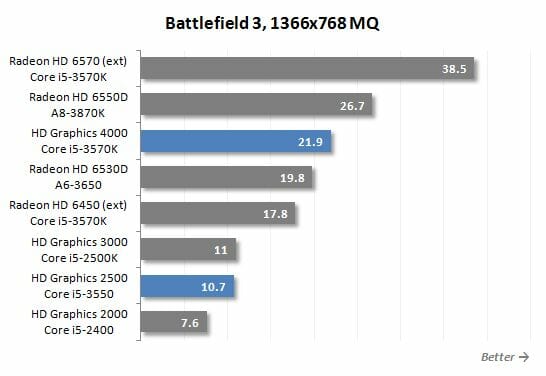
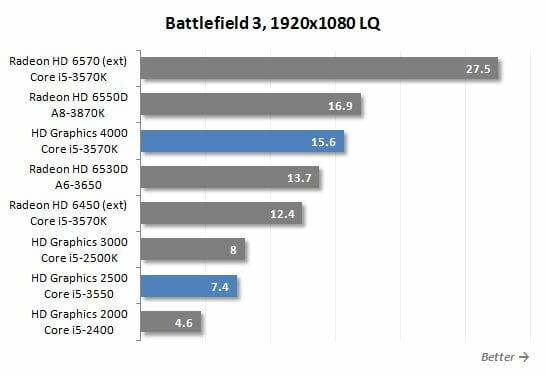
This popular first-person shooter doesn’t work fast enough when run on Ivy bridge graphics. Moreover, we experienced some issues with the game menu being incorrectly displayed during the testing process. Nevertheless, the conclusion about the performance of the new generation Intel HD Graphics remains the same. 4000 model is somewhat faster than the graphics core in AMD A6-3650 and Radeon HD 6450 graphics card. However, it yields to the senior graphics core model in Llano processors and is completely destroyed by discrete Radeon HD 6570.
Civilization V
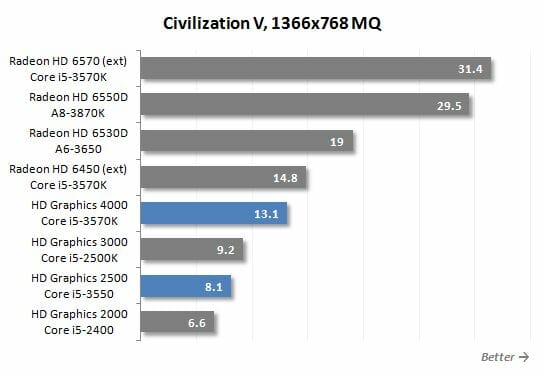
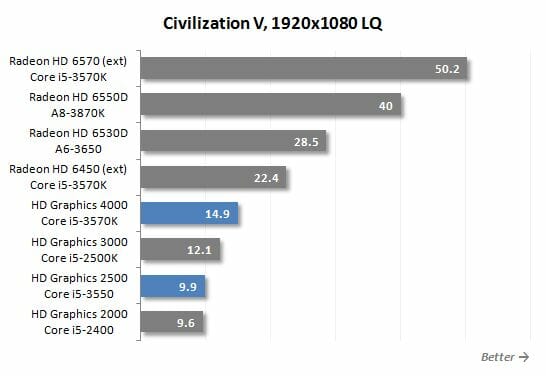
This popular strategy favors graphics solution on AMD architecture that is why they take the lead in this game. Intel’s graphics doesn’t do too good here: even HD Graphics 4000 is far behind the integrated Radeon HD 6530D as well as the discrete Radeon HD 6450.
Crysis 2
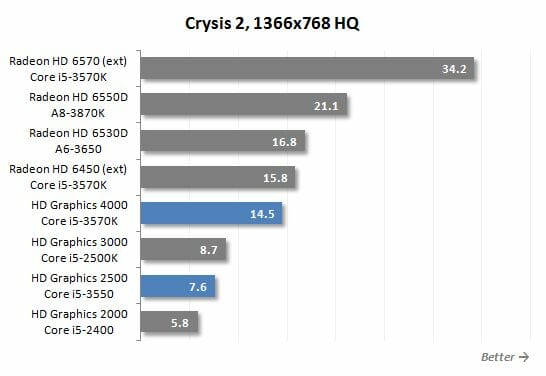
Crysis 2 is one of the most challenging computer games for graphics accelerators. And as we can see, the results illustrate that perfectly. Even though we didn’t enable DirectX 11 mode during our test session, Intel HD Graphics 4000 in Core i5-3750K processor didn’t do that well and was outperformed by the integrated core in A6-3650 as well as the discrete Radeon HD 6450 graphics card. To be fair I have to say that the improvement over Sandy bridge graphics is still pretty impressive and is present in the senior as well as junior models. In other words, the performance boost comes not only from the larger number of execution units. Even without any extra units, Intel HD Graphics 2500 is about 30% faster than HD Graphics 2000.
Dirt 3
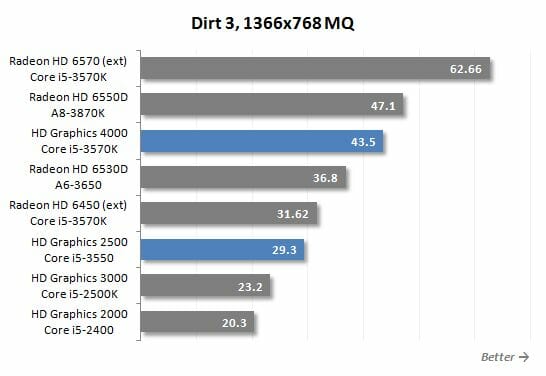
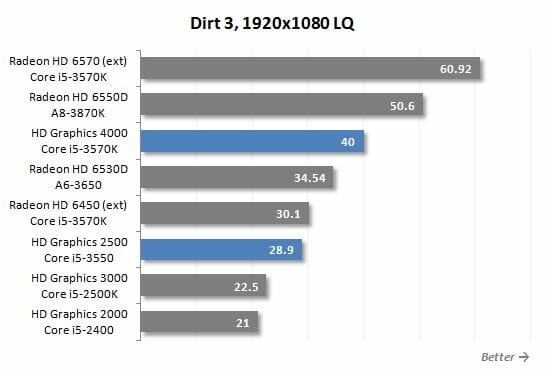
The situation in Dirt 3 game is pretty typical. HD Graphics 4000 is faster than the senior graphics core model in Sandy Bridge processors, while HD Graphics 2500 is about 40% faster than the integrated HD Graphics 2000. This places Core i5-3750K based system without the discrete graphics card right between the integrated platforms on AMD A8-3870K and AMD A6-3650. As for the graphics cards, only Radeon HD 6570 or faster models can actually compete against the new faster HD Graphics modification. All slower entry-level products stand no chance.
Far Cry 2
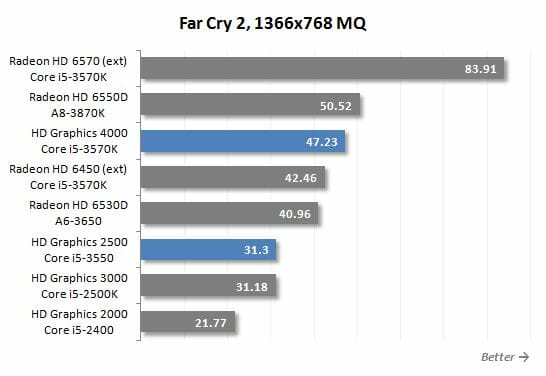
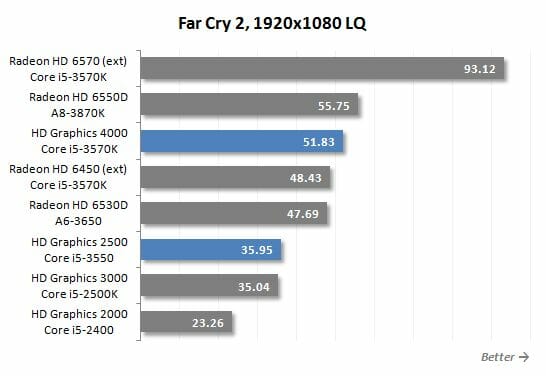
Look, the 4-year-old popular shooter can be played quite comfortably on the new integrated graphics from Intel. Although we still have to use low image quality settings, the diagram shows clearly how fast the performance of the Intel’s integrated graphics is increasing in the new processor generation. Assuming that they will keep up the same pace with the upcoming Haswell processors, next year we might no longer need such graphics cards as Radeon HD 6570.
Mafia II
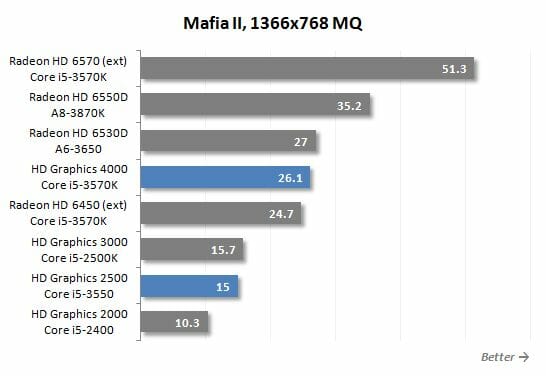
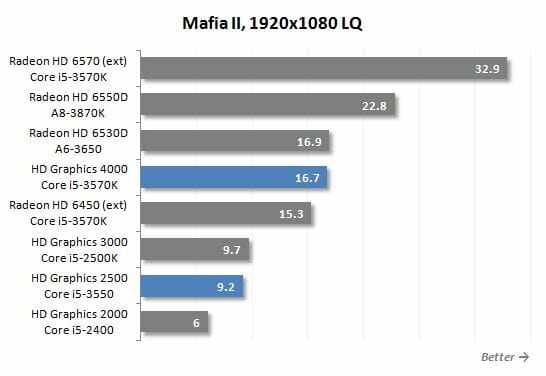
The integrated graphics in AMD processors looks even better than Intel HD Graphics 4000 in Mafia II game. And this is true for both: integrated Radeon HD 6550D and a slower Radeon HD 6530D from the Vision APU. So, we have to state once again that AMD Llano boasts a more advanced graphics core than Ivy Bridge. And the upcoming Vision processors based on Trinity will obviously push HD Graphics even farther back. Nevertheless, we can’t deny that Intel’s integrated graphics has improved dramatically. Even the junior 2500 model of the Ivy Bridge graphics core looks very impressive compared with the predecessors. With only six execution units it is almost as fast as HD Graphics 3000 from Sandy Bridge with twelve units like that.
War Thunder: World of Planes
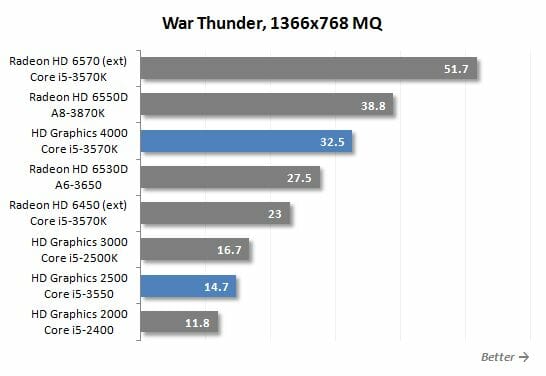
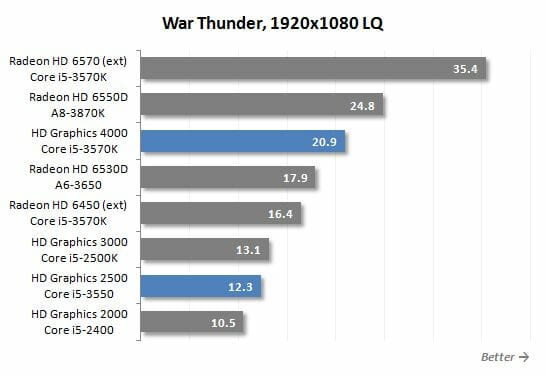
War Thunder is a new multi-player flight simulator, which should be released in the near future. However, the new integrated graphics cores are capable of delivering quite acceptable performance in this newest gaming title (if you do not set the image quality settings to their maximum, of course).of course, mainstream graphics cards will make the gaming experience more enjoyable, but we can’t call contemporary graphics solutions from Intel unfit for gaming either. This is primarily true for the HD Graphics 4000, which once again outperformed the entry-level discrete Radeon HD 6450 graphics card. The junior graphics core from the Ivy bridge processors doesn’t look as good, because its performance is only about half as good. That is why it is seriously behind not only discrete graphics accelerators, but also the integrated graphics cores in quad-core Socket Fm1 AMD processors.
Cinebench R11.5
All games we have discussed so far support DirectX 11. However, we would also like to check out new Intel graphics solutions in OpenGL. Therefore, we also completed a small performance investigation in the professional Cinema 4D suite.
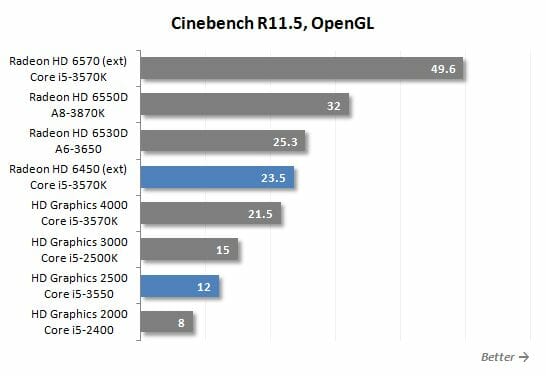
As you can see from the obtained results, we do not see anything different about HD Graphics performance in OpenGL applications. However, HD Graphics 4000 is still behind any integrated or discrete graphics accelerators from AMD, which win this round due to better optimized drivers.
Performance during Video Processing
In terms of video processing tasks, HD Graphics deals with two major processes. On the one hand, it is HD video playback (decoding), and on the other – transcoding (decoding and further encoding) with the help of Quick Sync technology.
As for the video transcoding, the new generation graphics cores are hardly any different from their predecessors. HD Graphics 4000/2500 support full hardware video decoding in AVC/H.264, VC-1 and MPEG-2 formats via DXVA (DirectX Video Acceleration) interface. It means that when you are playing back videos by DXVA compatible software players, the utilization of processor computational resources and its power consumption will remain minimal and all content decoding is performed by a special unit in the graphics core.
However, they promised the same exact thing in their Sandy Bridge processors, but in some cases we had to deal with pretty unpleasant artifacts (with certain players and during the playback of videos in specific formats). Of course, it didn’t have anything to do with any hardware issues in the decoder integrated into the graphics core, but was more likely the result of some software problems, but knowing this didn’t really change the situation for the end-users. Now it looks like they have finally been cleared of all issues and contemporary players play video just fine in systems with new generation HD Graphics and do not suffer from poor image quality any more. At least, we haven’t been able to detect any image quality issues in the publicly available Media Player Classic Home Cinema 1.6.2.4902 or VLC media player 2.0.1, as well as the commercial Cyberlink PowerDVD 12 build 1618.
As we have expected, the CPU utilization during video playback remains pretty low, because it is the video engine inside the integrated graphics core that bears the biggest load, and not the computational processor cores. For example, during FullHD video playback with enabled sub-titles, Core i5-3550 with HD Graphics 2500 core is only 10% utilized. Moreover, the CPU remains in power-saving mode, i.e. works at lower 1.6 GHz frequency.

I have to say that the hardware decoder is powerful enough to ensure problem-free playback of several different FullHD video streams and “heavy” 1080p videos encoded at about 100 Mbps bitrate. However, it is still possible to overload the decoder. For example, during the layback of an H.264 video in 3840×2160 resolution with about 275 Mbps bitrate, we witnessed some frame loss and freezing even though Intel promised full support of hardware decoding for high-resolution videos. However, the above mentioned QFHD resolution is used very rarely these days.
We also checked the performance of the second Quick Sync version implemented in Ivy Bridge processors. Since Intel promised to increase the transcoding speed in the new graphics cores, we focused primarily on the performance tests. During our test session we measured the time it took to transcode one 40-minute episode of a popular TV-show from 1080p H.264 10 Mbps bitrate format into a format compatible with Apple iPad2 (H.264, 1280×720, 4Mbps). We used two utilities supporting Quick Sync: Arcsoft Media Converter 7.5.15.108 and Cyberlink Media Espresso 6.5.2830.
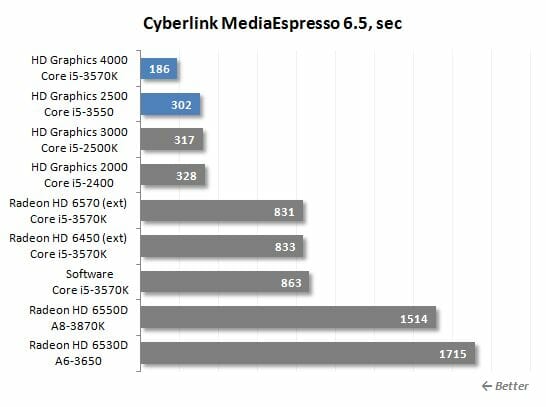
It is impossible not to notice that the transcoding speed has increased dramatically. Ivy Bridge processor with HD Graphics 4000 graphics core completes the test almost 75% faster than the previous generation processor with HD Graphics 3000 core inside. However, it looks like only the senior modification of the Intel’s graphics core experiences this unprecedented performance boost. Namely, we do not see a tremendous difference in the results like that when we compare the transcoding speed of HD Graphics 2500 and HD Graphics 2000. Quick Sync in the junior version of the new Intel’s Ivy Bridge graphics core is much slower than in the senior one that is why the video transcoding results of HD Graphics 2500 and HD Graphics 2000 processors differ by as little as 10%. However, there is no reason to be sad about it. even the slowest Quick Sync is way faster than software decoding or even any of the Radeon HD graphics cards that use programmable shaders to accelerate video transcoding.
I would like to say a few words about the video transcoding quality. They used to believe that Quick Sync technology produced significantly poorer images quality than careful software transcoding. Intel never denied it stressing that Quick Sync was a tool for fast transcoding and not for professional mastering. However, according to the developers, they improved the image quality produced by the new version of this technology by introducing some media sampler modifications. Did they manage to reach the same image quality levels as during software decoding? Let’s take a closer look at a few screenshots illustrating the transcoding of a FullHD original movie into Apple iPad 2 compatible format.
Software transcoding using x264 codec:

Transcoding with Quick Sync technology on HD Graphics 3000:

Transcoding with Quick Sync 2.0 technology on HD Graphics 4000:

Frankly speaking, I can’t notice any dramatic improvement in image quality. Moreover, it seems that the first Quick Sync version may be producing even better image: less washed-out image and more prominent details. On the other hand, excessive clarity of the picture on HD Graphics 3000 adds noise to the image, which is also not so good. In any case, if you are looking to get ideal image quality, then software transcoding would probably be your best bet, because it may offer you better quality video by applying more flexible settings. However, if you intend to playback your video on some sort of mobile device with a small display, it makes a lot of sense to use Quick Sync version 1 or version 2.
Power Consumption
One of the major advantages Ivy Bridge has over its predecessors is finer manufacturing technology using 22 nm process and 3D transistor structure. By improving the manufacturing process Intel promised not only to increase performance, but also lower the power consumption. This was implied in respect to computational as well as graphics cores. In order to estimate the scale of this improvement, we ran a few of our traditional power consumption tests.
The graphs below (unless specified otherwise) show the full power draw of the computer (without the monitor) measured after the power supply. It is the total of the power consumption of all the system components. The PSU’s efficiency is not taken into account. The CPUs are loaded by running the 64-bit version of LinX 0.6.4 utility. The graphics cards were loaded using FurMark 1.10.1 utility. Moreover, we enabled all power-saving technologies to correctly measure computer’s power draw in idle mode: C1E and Enhanced Intel SpeedStep for Intel processors, and AMD Cool’n’Quiet for AMD processors.
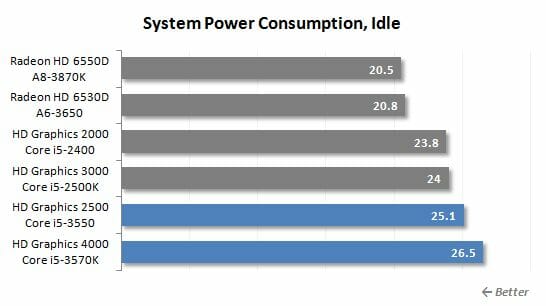
In idle mode Socket Fm1 systems consume about 4-5 W less than Intel competitors. However, the new Ivy Bridge processors with integrated graphics cores suddenly started to consume much more power than their predecessors. We have already witnessed a similar situation when there is a discrete graphics accelerator installed into an LGA 1155 platform.
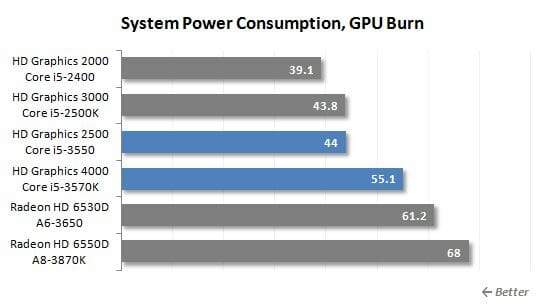
Once we load the graphics cores of the processors to their maximum, the situation changes dramatically. AMD processors become more power-hungry, and the power consumption of the Intel HD Graphics cores becomes directly proportional to their performance. In other words, Ivy Bridge consume more power than their predecessors during graphics 3D load.
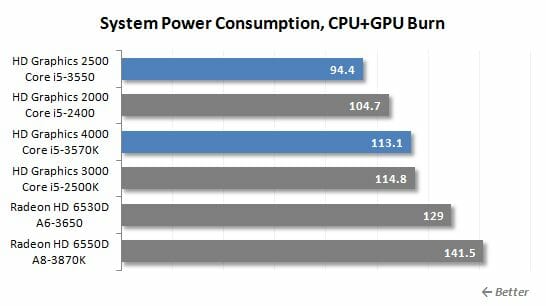
However, when both cores – processor and graphics – are fully utilized, Ivy Bridge does become more energy-efficient. While the difference between Ivy Bridge and Sandy Bridge was not too serious, when we tested the same processors in systems with discrete graphics accelerators, the ones manufactured with new production process demonstrated their energy-efficiency more confidently. As for AMD solutions, they can’t compete against Intel in performance-to-power consumption ratio. As we know quad-core Llano processors don’t get even remotely close to Core i5 in computational performance, but their power consumption is significantly higher.
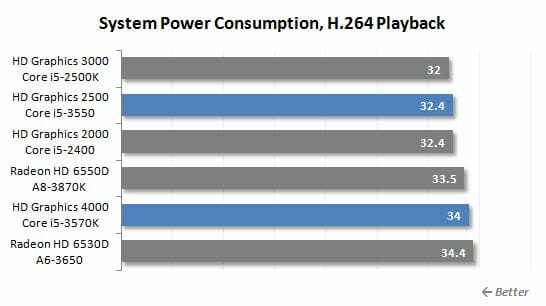
Another example of complex operational load is HD video playback. The numbers here are very close to what we have just seen in idle mode, the biggest difference being 7-8 W more. Hardware video decoders built into the graphics core allow the computational cores to remain in power-saving modes, that is why all tested systems remain pretty energy-efficient in this case. Although I have to point out that processors with a lot execution units (HD Graphics 4000) or shader processors (Radeon HD 6550D) in their cores consume much more power.
Conclusion
The tempo Intel has set for the development of their integrated graphics core is truly impressive. It may seem that we have just recently admired the ability of the Sandy Bridge graphics to compete against entry-level graphics cards, but the new generation of processor design called Ivy Bridge again pushed the performance bar another step forward. This progress is particularly impressive considering that Ivy Bridge microarchitecture is not positioned as a new development, but merely as a transition of the old design to more advanced technological level with only a few minor improvements. Nevertheless, the launch of Ivy Bridge brought with it a new version of integrated HD Graphics cores with not only higher performance, but also DirectX 11 support, enhanced Quick Sync technology and ability to process general-purpose calculations.
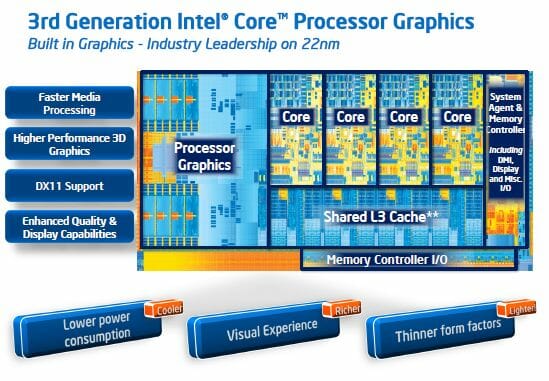
However, in reality there are two versions of the graphics core and they are seriously different from one another. The top modification, HD Graphics 4000, is exactly the product that will trigger your fascination. Its 3D performance compared with HD Graphics 3000 increased by about 70%, which positions it somewhere between contemporary discrete graphics accelerators such as Radeon HD 6450 and Radeon HD 6570. Of course, it is not a record for integrated graphics and solutions integrated into top AMD Llano processors work somewhat faster, but at least Intel managed to defeat Radeon HD 6530D from the AMD A6 series processors. And with 75% faster Quick Sync technology Intel HD Graphics 4000 doesn’t have any alternatives and may become a desired option for mobile systems as well as for desktops (not the gaming kind though).
The second modification – Intel HD Graphics 25000 – is significantly weaker. Although it also supports DirectX 11, it is more of a formal improvement. It is almost always slower than HD Graphics 3000 and therefore can’t compete against any discrete graphics accelerators. In other words, HD Graphics 2500 seems to be a solution which 3D functionality is merely a formality, but not really a serious feature. Namely, HD Graphics 2500 is a good choice for media players and HTPC, because its video transcoding and decoding functions remained untouched, but hardly an entry level 3D accelerator. Although many of the previous-generation games may probably run acceptably on HD Graphics 2500.
Judging by the way Intel distributed their new HD Graphics 4000/2500 cores among the processors, the company’s opinion about them and their potential is very similar to ours. The top 4000 model is targeted primarily for notebooks where there is high demand for integrated and high-performance solutions but discrete graphics threatens the mobility of the platform and therefore is not a preferred choice. As for the desktop segment, HD Graphics 4000 may be a part of rare custom products or as part of expensive CPUs, which cannot come with anything of limited functionality by definition. That is why most desktop Ivy Bridge processors are equipped with HD Graphics 2500 core, which doesn’t affect the discrete graphics card market.
Nevertheless, Intel indicates clearly that integrated graphics solutions are one of their current priorities. And while processors with integrated graphics can now only affect the mobile products, they have the potential to become an alternative to discrete desktop graphics accelerators at some point. Time will show what will happen.